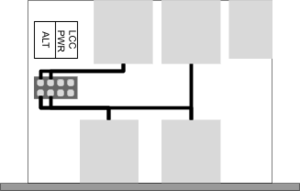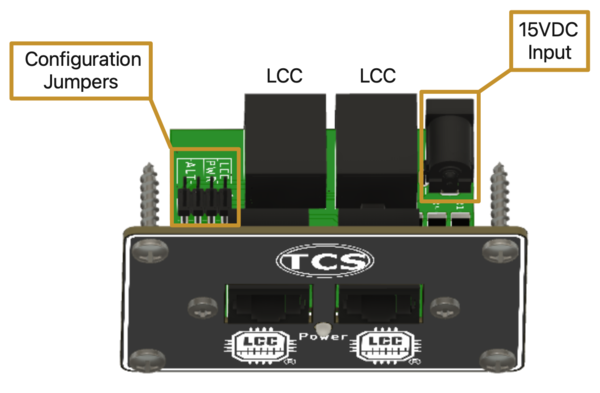LCC Throttle Panel: Difference between revisions
No edit summary |
No edit summary |
||
| Line 18: | Line 18: | ||
*Fascia mounting screws x4 | *Fascia mounting screws x4 | ||
*Fascia cover plate screws x2 | *Fascia cover plate screws x2 | ||
===Physical Overview=== | |||
The LCC Panel has a few notable physical features: | |||
#2.5mm x 5.5mm barrel jack for LCC Power In | |||
#Configuration Jumpers (see details below) | |||
#Four "LCC" RJ-45 jacks (2x Front: For T-50; 2x Rear for LCC Bus) | |||
#Red LED for LCC Power | |||
[[File:LCC Panel (2).png|frameless|600x600px]] | |||
===Configuration Jumpers=== | |||
Refer to the table below for information on the configuration jumpers available on the LT Panel: | |||
{| class="wikitable" | |||
!Jumper Position | |||
!Description | |||
|- | |||
|(1 & 2) LCC PWR | |||
|Insert this jumper to add termination to the LCC-CAN bus. An LCC-CAN bus should have exactly two terminators, with one at each end of the bus. | |||
This jumper can (optionally) provide for one of the required terminators. | |||
''Note: In practicality, a very short (less than 10ft or 3m) LCC-CAN bus can still work reliably with one terminator.'' | |||
|- | |||
|(3 & 4) ALT | |||
|[[File:LCC Panel ALT Simplified Diagram.png|thumb|300x300px|Simplified diagram showing the electrical connection for ALT jumpers.]]Insert these two jumpers to pass the low power DCC signals through the LCC panel (pins 4 & 5 of the LCC-CAN standard). | |||
Remove these jumpers to disconnect the low power DCC signals from passing through the panel. | |||
''Note: The LT Panel uses the [https://www.nmra.org/sites/default/files/standards/sandrp/pdf/s-9.1.2_power_station_interface.pdf NMRA S-9.1.2 Full Scale Interface]'' | |||
ALT is a low-power mirror of the track output from the command station. | |||
This circuit is only intended to be used to pass the signal throughout the panel to other connected devices on the LCC-CAN. | |||
This circuit is '''not''' intended to daisy-chain signals to LCC boosters such as the B-106. This should be done directly. | |||
This circuit '''must be disabled/open''' if you plan to use an LT-50 as a tethered throttle with a CS-105 also connected | |||
to this panel. | |||
|} | |||
Revision as of 02:48, 27 August 2022
Lua error: Internal error: The interpreter exited with status 1.
This product is an expansion panel for an LCC network, such as those created and used by the CS-105 and LT-50. Use this product to expand the number of wired throttles such as the T-50 you can connect to the TCS command station, or to provide an access point for other LCC devices distributed around your layout.
The LCC Throttle Panel also includes a jack you can use to connect a Power Supply to power the LCC bus. (Not Included)
Included In Package
- LCC throttle panel board x1
- Fascia cover plate x1
- Fascia mounting screws x4
- Fascia cover plate screws x2
Physical Overview
The LCC Panel has a few notable physical features:
- 2.5mm x 5.5mm barrel jack for LCC Power In
- Configuration Jumpers (see details below)
- Four "LCC" RJ-45 jacks (2x Front: For T-50; 2x Rear for LCC Bus)
- Red LED for LCC Power
Configuration Jumpers
Refer to the table below for information on the configuration jumpers available on the LT Panel:
| Jumper Position | Description |
|---|---|
| (1 & 2) LCC PWR | Insert this jumper to add termination to the LCC-CAN bus. An LCC-CAN bus should have exactly two terminators, with one at each end of the bus.
This jumper can (optionally) provide for one of the required terminators. Note: In practicality, a very short (less than 10ft or 3m) LCC-CAN bus can still work reliably with one terminator. |
| (3 & 4) ALT |  Remove these jumpers to disconnect the low power DCC signals from passing through the panel. Note: The LT Panel uses the NMRA S-9.1.2 Full Scale Interface
This circuit is only intended to be used to pass the signal throughout the panel to other connected devices on the LCC-CAN. This circuit is not intended to daisy-chain signals to LCC boosters such as the B-106. This should be done directly. This circuit must be disabled/open if you plan to use an LT-50 as a tethered throttle with a CS-105 also connected to this panel. |
